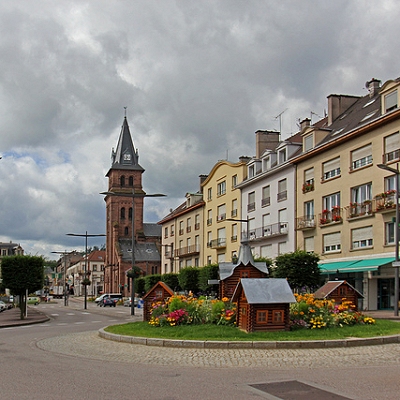
Like us on Facebook
PLACE NAMES


 
|
|
Saint-Dié des Vosges
|

| |
Saint-Dié is located in the Vosges Mountains 80 km (50 mi) southeast of Nancy and 45 km (28 mi) of Lunéville. This route in the valley of Meurthe was always the more frequented, and first to get a rail line in 1864, so now it accommodates the primary road.
Saint-Dié-des-Vosges, principal town of an arrondissement of the same name, belongs to the Vosges département of France. This commune with a little town in her center, is approximately 50 km (31 mi) northeast of Épinal, and connected by two roads, south through the passes of Haut-Jacques and Bruyères or north by the pass of Haut-du-Bois and the ancient land of Rambervillers. By rail, Épinal is 61 km (38 mi)] from Saint-Dié.
The river Meurthe flows in the Permian basin of Saint-Dié surrounded by wooded mountains, Ormont, Kemberg and La Madeleine. The peaks of these mountains are 550 m high, and are composed of Triassic formations, especially the so-called "Vosges sandstone", a kind of red sandstone.
The town was nearly completely redesigned and rebuilt in the French Uniform Style after the fire of 1757. A major part was destroyed in November, 1944 and was rebuilt largely in a material imitating red sandstone. Its cathedral has a Gothic nave and choir designed in the 14th century; the portal of red stone was created by Giovanni Betto in the beginning of the 18th century. A cloister, begun in the 14th century but never finished, contains a stone pulpit, and connects with the Petite-Eglise or Notre-Dame-de-Galilée, a well-preserved specimen of Romanesque architecture of the 12th century. All of the monuments were restored or rebuilt in the same manner after 1950.
Since 1880, the Council House "Mairie" has held a marvelous theater, a library with some old and valuable manuscripts, a reading hall and a museum of rocks and antiquities collected by the members of the Vosges Philomatic Society. This society, which engaged in the collection and diffusion of knowledge, was founded in 1875 by Henry Bardy, who was soon an editor of the first local republican paper named La Gazette Vosgiennne. All this center of town was destroyed in November 1944.
After 1948, a new hôtel-de-ville was built 100 meters to the west. At its west side there is now a monument by Merci to Jules Ferry, long ago in an old union place under the Cathedral. Born in the town in 1832, Jules Ferry was a great French politician of the conservative Republic, constitutionally called Third Republic in 1875.
After World War II, the right side of the Meurthe was completely razed and most people lived outside the town in wood cabins for decades. The radical plan created by Le Corbusier in 1945, which called for a large plaza with factories and other buildings in the heart of the city, was rejected in 1947, and only one private factory belonging to Jean-Jacques Duval was ever built. There were no means nor materials in this terrible period and the great street called "rue Thiers" was finished only at the end of 1954.
 Feel free to Email me any additions or corrections Feel free to Email me any additions or corrections
LINKS AVAILABLE TO YOUR SITE
| | |





